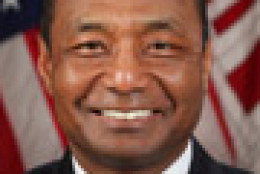Defense
-
Records show the civilian truck driver who killed a sailor at the world's largest Naval Base was a felon. Jeffrey Tyrone Savage was convicted of voluntary manslaughter and spent time in prison for possession of crack cocaine with intent to distribute.
March 28, 2014 -
The Littoral Combat Ship program is struggling to stay afloat financially. But Congress has another concern. The ships themselves might be easy to sink. Navy Secretary Ray Mabus testified before the House Appropriations Defense Subcommittee on the Navy's budget request yesterday. Subcommittee member Ander Crenshaw (R-Fla.) asked him to explain how this is possible if the LCS is supposed to be the ship of the future.
March 26, 2014 -
The hallways of a building at Joint Base Anacostia-Bolling echoed with the sounds of gunfire last month as part of a training exercise to help base law enforcement personnel prepare for an active-shooter event.
March 25, 2014 -
The Army has a wardrobe problem. For years, the service has tried to improve its camouflage uniforms. But the process has been plagued by financial, technical and political problems. While that project stalls, the Army's PEO Soldier Unit is developing armor, helmets and other equipment for warfighters. Col. Robert Mortlock, program manager for the Army's Soldier Protection and Individual Equipment office, spoke with the Federal Drive's Tom Temin and Emily Kopp about the latest efforts on the Army's wardrobe front.
March 25, 2014 -
The "white hats" can never let up in the drive to stay ahead of cyber mischief makers. The Cyber Security Research Alliance recently announced its teaming up with Drexel and George Mason University to research some of the big cyber and physical security problems in the country. Lee Holcomb, president of the alliance and deputy of Technical Operations at Lockheed Martin's Information Systems and Global Solutions, spoke with Federal Drive hosts Tom Temin and Emily Kopp, about the work the group is doing. Lockheed Martin is a founding member of CSRA.
March 25, 2014 -
Over the past 12 years, the Army Corps of Engineers has had a full plate — building new facilities for the last round of base realignments, dealing with the aftermath of Hurricane Katrina, and a lot of overseas construction in Iraq and Afghanistan. But as wars and military budgets draw down, it's time for the agency to reshape itself, says Lt. Gen. Thomas Bostick, the Corps' commanding general. He spoke with Federal News Radio DoD Reporter Jared Serbu. Hear Jared's full hour-long interview with Bostick, Weds. March 26 at 3p.m. Listen here.
March 25, 2014 -
Adm. Jonathan Greenert, chief of Naval Operations, is creating a task force to draw up recommendations for alternatives to the Littoral Combat Ship. That program has driven controversy since its inception from both a cost and operational perspective. Retired Vice Adm. Lou Crenshaw, principal of Crenshaw Consulting Associates, discussed the program on In Depth with Francis Rose.
March 24, 2014 -
Horace Blackman, a long-time Veterans Affairs IT executive, also leaves for the private sector, joining Lockheed Martin.
March 24, 2014 -
The Navy takes pointers from Google Glass to create the next generation of military training.
March 21, 2014 -
The Pentagon will complete the Joint Regional Security Stacks in the European theater by the end of this year, two years earlier than planned. DoD already has begun to construct this regional cyber approach in the U.S. as part of its Joint Information Environment program.
March 21, 2014 -
An update about how robotic, unmanned vehicles will augment brigades of the future.
March 20, 2014 -
Newly-released results of three parallel investigations into last September's Washington Navy Yard shootings point to serious gaps in the government's own security process. But the Navy's review finds the killings could have been prevented if the shooter's employer had disclosed troubling details about his recent behavior.
March 18, 2014 -
As the combat mission in Afghanistan comes to a close, the awards process is up for review.
March 18, 2014 -
The Navy's newest approach to responsible drinking is only a download away.
March 18, 2014 -
A decade's worth of catch-up coming in the Air Force.
March 17, 2014












